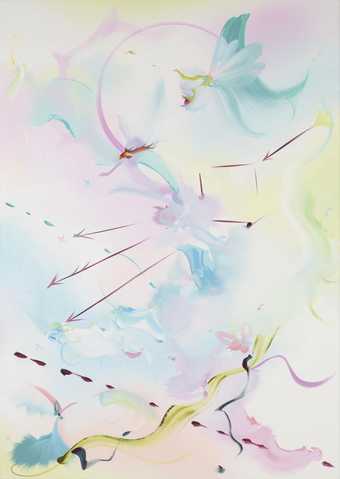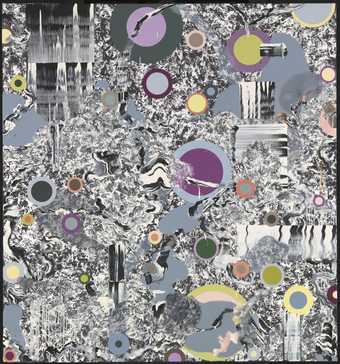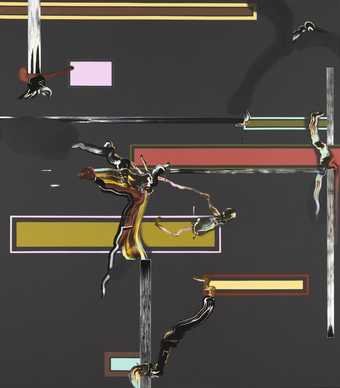We visit Fiona Rae's London studio as she put the finishing touches to works for her new exhibition at the Timothy Taylor Gallery. The artist talks about her enduring love for paint. Her abstract canvases are an exuberant collision of painting styles: encrusted surfaces, brushy swathes and watery pools, along with kitsch cartoon elements, which somehow unite despite their differences.
This is my studio in Hackney. I’ve been here about ten years, and for the last year or so I’ve been working towards my exhibition in London. I work on my own. I prefer to be on my own because I can concentrate better that way. In the past I’ve had assistants come in and help with stencils or background colours, things like that, but I prefer to be on my own. This is my oil paint table. I love having a really long, big palate, eight foot long, so I can mix up as many different colours as I might need for a particular painting, and keep it quite clear and kind of business-like. This is my trusty plastic pot thing, and I put some stand oil in it with this German stuff called Shellsol, which is less poisonous than turpentine, but a similar kind of thing. For years I used turpentine, which is just really appalling for your health. And you swish it around a bit, and it makes a slightly viscous solution that you can mix oil paint with to stiffer or more kind of watery effect. Oil paint is fantastically versatile. You can just do almost anything with it. You can make it look like plastic, you can make it look like chalk, you can make it go into thick mountains or thin pores. Occasionally I put one or two other kinds of things in, but on the whole I just stick with this very simple formula that actually someone at the Tate told me about when I first left college. This is my brush collection, and again it’s on a table with wheels on it, because actually it’s really handy to be able to shove it out the way. This is my dinosaur mascot that I’ve had for a very long time. And again, I like to lay things out so that I can see what I’ve got. Sometimes I want a very particular type of brush, and I can see where it is and that I have it. Unfortunately they do get damaged, brushes, because I don’t use them entirely how you’re supposed to. I think you’re only supposed to let the paint go up to there, and do all careful things, but in fact I give them some pretty heavy abuse sometimes. In the bottom tray as well, these are brushes I use less of, like strange kind of super-long ones, or draught-excluders just in case, or very big glue brushes. But I’m not doing this kind of thing so much at the moment. I’m keeping it pretty much within a range of quite painterly brushes. I never think of painting as old-fashioned. I mean, in a way TV is old-fashioned, and video is old-fashioned, and installation is old-fashioned. Everything is old-fashioned the minute it has been around a year or two. So I think it’s as valid as any other art form, and has as much possibility in it as any other art form. It’s really what you bring to these art forms that matters, not necessarily the form that you choose to express your ideas in. So for me it’s completely alive and kicking, and up for wrestling with. Okay, so these are palates that I have used, and I’ve just chucked them on the floor rather than put them in the bin just yet, because sometimes I need to pick up a colour again and know exactly which colour it was. And sometimes it has even been useful to have all this dried, congealed stuff, because it gave me an idea. You see on this painting, I had one of these old palates kicking around, and it seemed obvious to me that I should scrape it up and put it there, so I’ve got this thick impastoey stuff that I wouldn’t have done if I had just had a clear, delicious, clean palate. I’ve got a drawer full of things that I printed out and cut up. In this box, this source imagery is kind of cartoony, childlike stuff, I guess. I think it’s got a playful quality. I found these things on the internet which – I’ve got no way of using it, but I just printed it out anyway just in case. It seems to me amazing that there are all of these different things you can do with paints, and to my mind, why restrict yourself? I don’t mind how people look at my paintings. I don’t mind if they just like the colours. It’s great if they even look at them, so if they like the colours, that’s great, if they like the shapes, the way the paint walks and talks, is great. But I wouldn’t want to prescribe what people should or shouldn’t think about them. I mean, if they want to think about something post-modern that’s fine. If they want to think about something old-fashioned and poetic, that’s fine too. Is poetic always old-fashioned? I hope not.






